Therapeutic laser (light amplification by stimulated emission of radiation) for veterinary patients helps the body's natural healing process, decreases healing time, alleviates pain and inflammation, and helps to delay progressive diseases (Lindley and Watson, 2010; Millis and Saunders, 2014).
Therapeutic laser can be used immediately following procedures, in postoperative healing, and in a variety of disease processes. (Levine and Millis, 2014) (Figure 1).
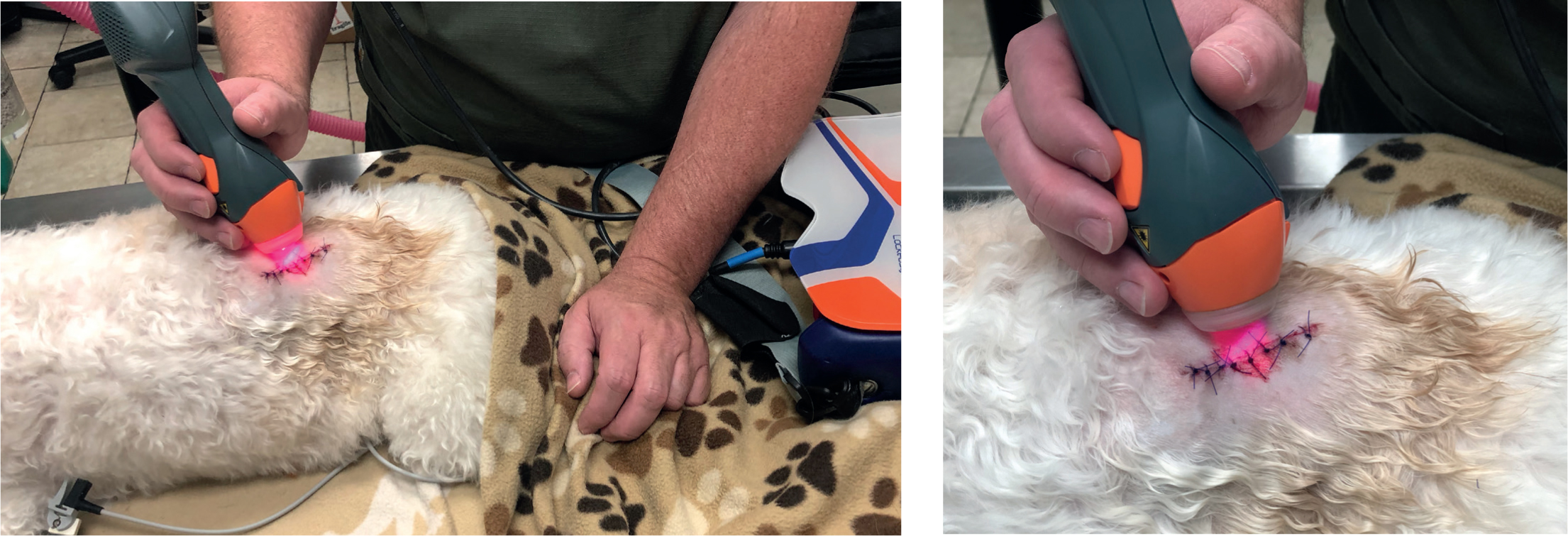
In order to properly use this tool, the veterinary nurse must know what a therapeutic laser is, how it works, and how to handle it properly for each case. Once these concepts are mastered, therapeutic laser can be used by the veterinary nurse, under the supervision of the veterinarian, on a daily basis to help patients with a variety of needs.
What is therapeutic laser?
Laser therapy or photobiomodulation is a photochemical process in which light from a laser interacts with cells and causes stimulation or other biochemical changes (Pryor and Millis, 2015). Depending on the wavelength emitted by the laser unit, different parts of the body are affected by the laser's varying penetration. The intensity and depth of the laser's penetration into the patient's tissues provide various effects on the body's ability to heal. Laser light typically falls within the infrared or near red portion of the electromagnetic spectrum (Levine and Millis, 2014).
In veterinary medicine, the two classes of lasers used for therapeutic purposes are class 4 and class 3b (Lindley and Watson, 2010). Lasers are classified based on the amount of damage they can cause to a tissue, with class 1 being the least damaging (Levine and Millis, 2014). Class 3b and class 4 are the lasers used for therapeutic effects on tissues, but should be used with caution as they can cause damage to tissue that is not meant to be exposed to these lasers (Levine and Millis, 2014) (Figure 2).
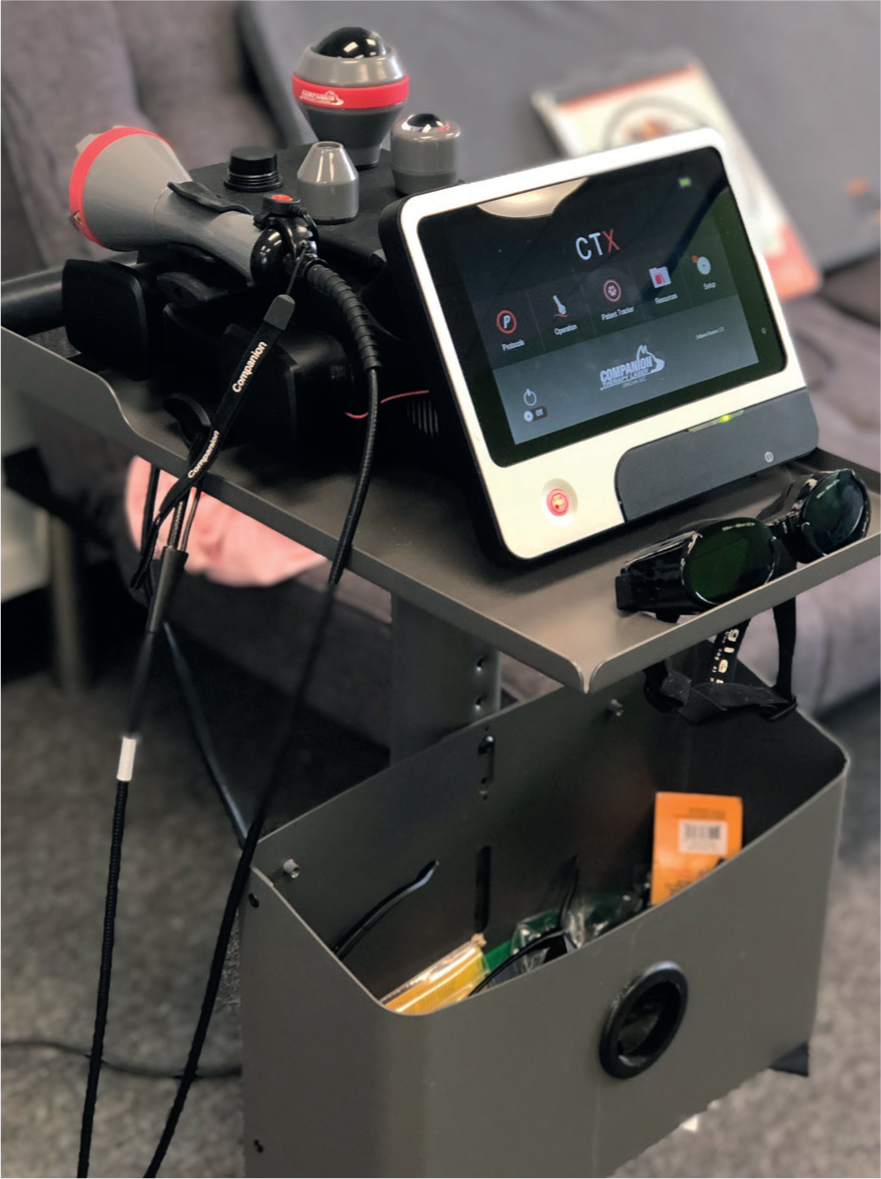
Although photobiomodulation is not fully understood, scientists believe that the laser has several mechanisms of action (MOA) depending on the target area of the body (Pryor and Millis, 2015). The most understood MOA is its effect on cytochrome c found in the photoreceptor, mitochondria. Once cytochrome c is hit by the laser, it breaks bonds with nitric oxide, allowing bonding with the oxygen to become more prevalent and cytochrome c oxidase to be produced at an optimal rate. This is critical to the creation of ATP. ATP is the energy-carrying molecule in the cell and aids in secondary mechanisms such as reducing pain and inflammation in the body and playing a role in tissue healing. The more ATP that is created, the more energy is available to the cells to perform these important functions (Pryor and Millis, 2015) (Figure 3).
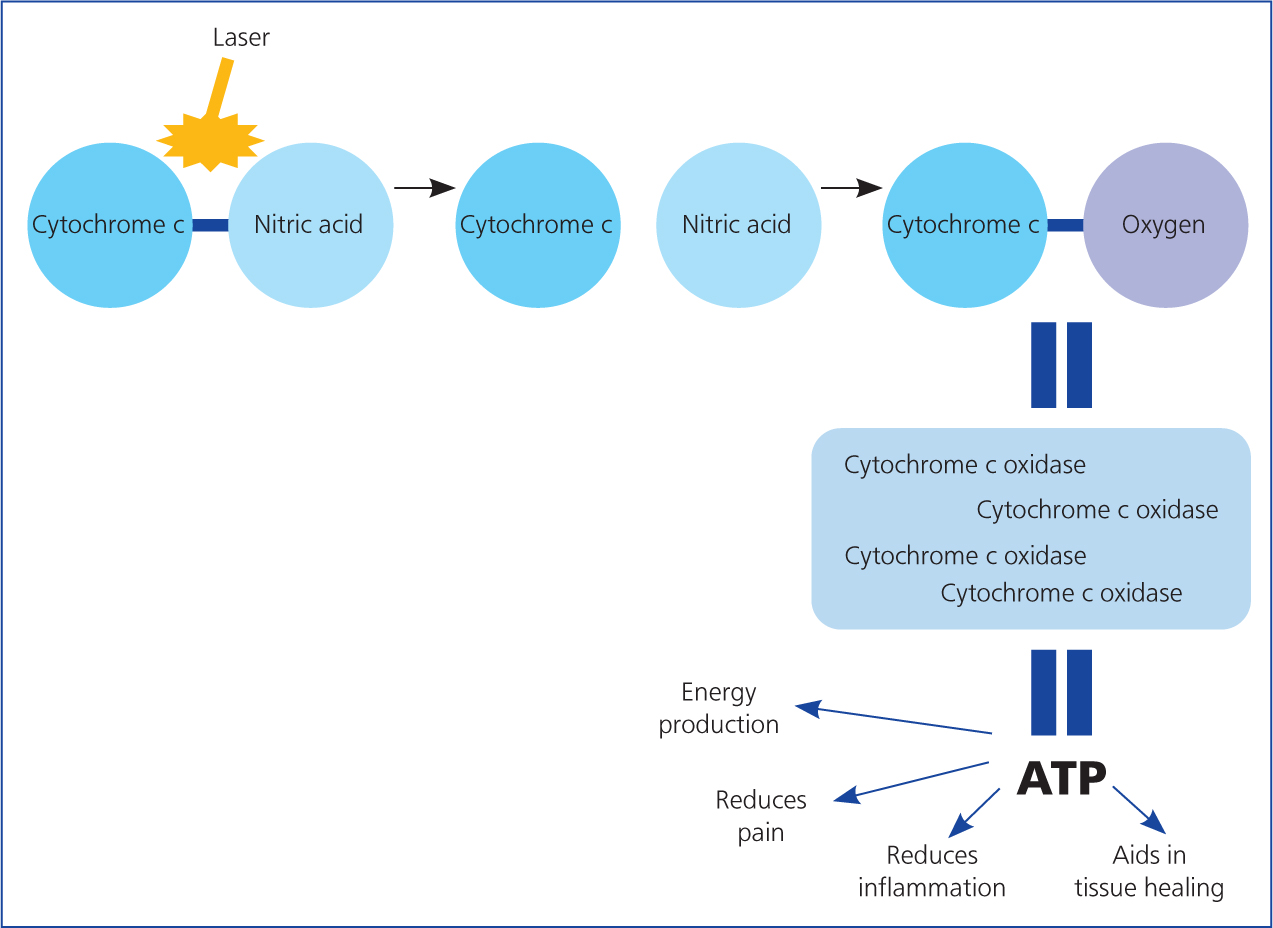
There are many studies to support therapeutic laser in the reduction of pain, reduction of inflammation, and the promotion of healing in the body (Table 1) (Tajali et al, 2010; Bhargava et al, 2011; Wyszyńska and Bal-Bocheńska, 2018).
Table 1. Benefits of laser therapy
| Reducing pain | Reducing inflammation | Promoting healing |
|---|---|---|
| Increases serotonin levelsIncrease in nitric oxide, enhancing oxygen deliveryImprove axonal sprouting and nerve cell regeneration | ATP productionAcceleration of leukocyte activityDecrease in prostaglandin synthesisLymphocyte response | Increased macrophage activityKeratinocyte proliferationIncreased growth factorsGreater wound tensile strength |
More research would be beneficial in deepening the understanding of the uses of therapeutic laser in veterinary medicine. With more interest in the area, there will hopefully be further studies for more evidence-based veterinary medicine.
Utilisation of the therapeutic laser
Precautions when operating the therapeutic laser unit
There are several different types of therapeutic lasers for veterinary use. Each one should be handled with care and only used by trained staff. Safety classes are available to train staff on how to properly handle the therapeutic laser equipment.
Caution should be used at all times when operating a therapeutic laser unit. Protective eyewear should be worn by both the veterinary professionals and patient (Figure 4).
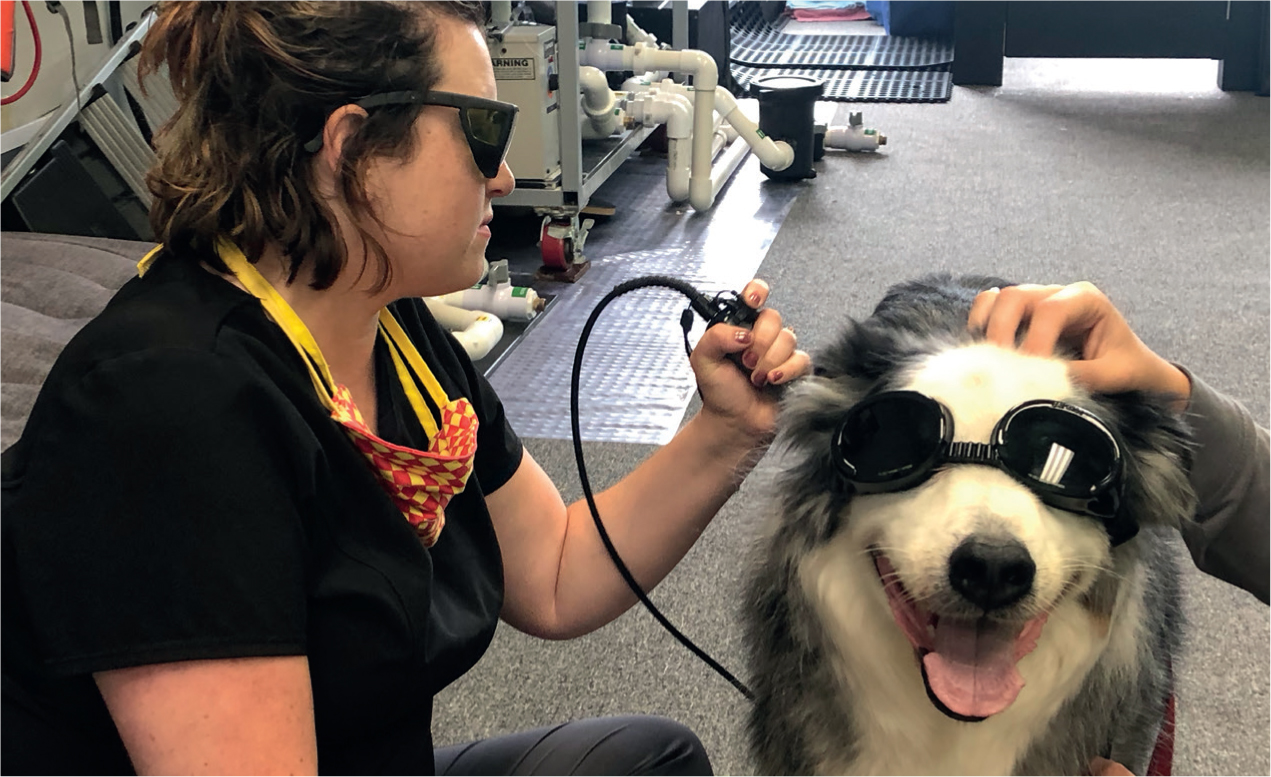
Signs should be posted on the door and in the room where the therapeutic laser is used to caution anyone entering that a laser might be in use (Tear, 2012). Reflective surfaces should be removed from the room when operating a laser to lessen the likelihood of the laser reflecting off the surface and causing damage to personnel (Levine and Millis, 2014).
Class 3b and class 4 lasers both can cause damage if not used properly. They can potentially burn skin or cause permanent eye damage. If a laser is left hovering over jewellery or other metal instruments, it can heat up and cause burns on the patient or nurse's skin. Jewellery, metal collars, and anything else that could heat up should be removed before beginning the therapy (Pryor and Millis, 2015). There is also a risk of starting fires with lasers, and lasers should never be left turned on unattended. They should also never be placed on flammable material such as carpet or a towel (Bassert and Thomas, 2014).
How the laser penetrates the tissues
Laser light interacts with tissues in various ways. Light may be reflected, scattered, transmitted, or absorbed (Levine and Millis, 2014). Reflected, scattered, and transmitted photons do not provide any benefit to the patient's tissues and may bounce off objects in the room and cause injury, such as hitting the eyes of anyone in the room. Absorbed photons are the part of the laser that affects the tissues by being absorbed by chromophores, such as cytochrome c (Levine and Millis, 2014).
Lasers have differing effects depending on the range of wavelengths used. Wavelengths in the range from the blue (400 nm) to the mid infrared (1100 nm) can result in a photochemical change in cells (Pryor and Millis, 2015). Depth of penetration is one of the most critical elements of laser treatment (Pryor and Millis, 2015). The ‘therapeutic window’ or ideal range of wavelengths for penetration into tissues is 600 nm to 1100 nm (Pryor and Millis, 2015).
The longer the wavelength the more penetration into the tissues achieved (Pryor and Millis, 2015). If treating surface wounds, a shorter wavelength will be needed than if a deep tissue injury is being treated. Depending on the patient's needs, wavelengths will can be adjusted for optimal efficacy (Pryor and Millis, 2015). Most laser companies now have built in software that selects the proper wavelength and power settings based on the information inputed about the patient, site of therapy, and therapeutic goals.
Postoperative patients
Patients coming out of surgery and during their recovery from surgery benefit from therapeutic laser to assist in the healing process (Van Dyke and Zink, 2018). Therapeutic laser can be administered as the patient is waking up from anaesthesia after a procedure. The therapeutic laser can aid in the healing process of the incision site (Van Dyke and Zink, 2018). This is helpful for any invasive procedure.
For patients with extended recovery from procedures, such as orthopaedic surgery, ongoing therapeutic laser treatment is beneficial. The laser therapy will aid in the recovery of the tissues and muscle around the repair. The laser helps to reduce inflammation and promote healing around the surgical site. It will help to improve wound healing, especially in its early stages (Singh et al, 2011).
Arthritic patients
Patients with chronic conditions, such as arthritis, benefit from routine therapeutic laser sessions. These can be performed once to several times weekly depending on the patient's needs and the owner's abilities (Figure 5). Therapeutic laser helps to slow the progression of arthritis as well as provide reduction of inflammation and trigger regrowth in cells (Fox and Millis, 2010; Wyszyńska and Bal-Bocheńska, 2018).
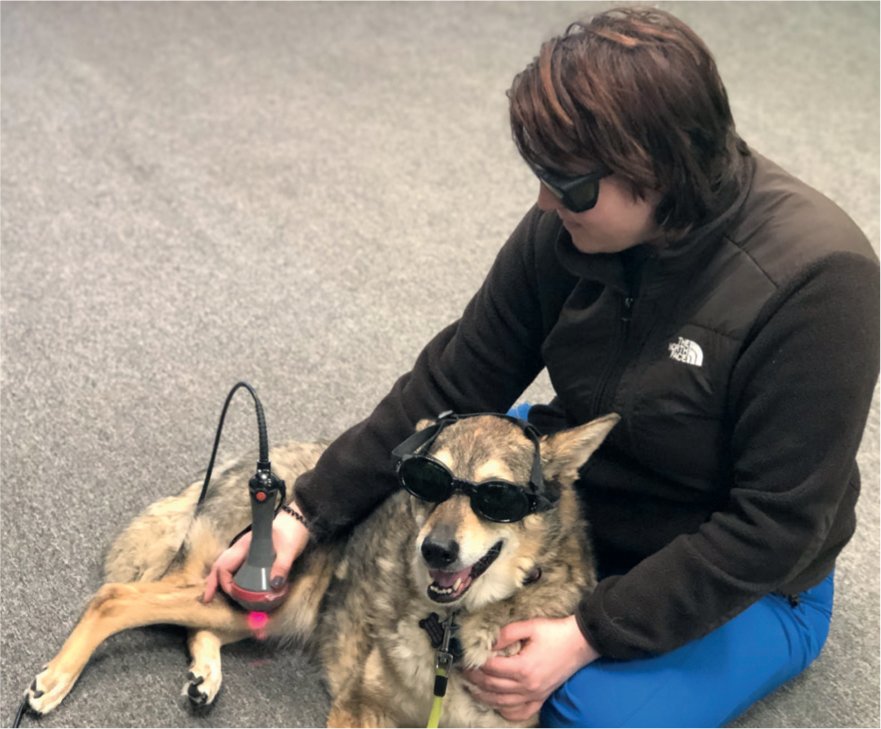
Neurologic diseases
Much like arthritic patients, patients with neurologic conditions will benefit from therapeutic laser (Fessehav, 2020). The therapeutic laser can help to slow the progression of neurologic diseases. The laser can also stimulate areas affected by neurologic conditions, helping to retrain the brain to send signals to the affected area. This can help regress neurologic diseases and help the patient regain feeling or use of the affected areas of the body. The stimulation of regrowth and healing from therapeutic laser use helps to make this possible (Levine and Millis, 2014).
Other conditions
Therapeutic laser can help with many other conditions in veterinary patients. Patients with urinary tract infections, ear infections, lick granulomas, and various other conditions can be treated with therapeutic laser alongside medications or other treatments. The therapeutic laser can help to reduce any inflammation and promote healing within the body (Levine and Millis, 2014).
Therapeutic laser is typically performed in conjunction with additional therapies and treatments for a full recovery of all conditions.
Contraindications of therapeutic laser
Therapeutic laser should not be used on patients that have cancer or are believed to have cancer. Since the therapeutic laser stimulates growth in cells, it may stimulate the cancer cells to grow at an increased rate (Van Dyke and Zink, 2018).
Patients that have epilepsy that can be triggered by photosensitivity should not have laser therapy performed on them. Lasers should not be used over the growth plate of a patient or over the patient's gonads. Lasers should be used in limited amounts over areas that have a metal implant. The laser could cause the plate to heat up and cause tissue damage to the patient. Lasers should not be used over the eye or endocrine glands. Lasers should also not be used on pregnant patients (Van Dyke and Zink, 2018).
Conclusion
Therapeutic laser is an increasingly popular treatment for a variety of diseases, injuries, and postoperative recoveries. With a proper understanding of the therapeutic laser, the veterinary nurse will be able to use the laser to help their patients recover more quickly, feel less pain, and slow the progression of some diseases.
KEY POINTS
- Therapeutic laser can benefit patients recovering from many illnesses or injuries.
- Postoperative, arthritic, and neurologic patients can all benefit from therapeutic laser treatment.
- Therapeutic laser penetrates tissue to encourage cell growth and healing.


